Anyway, the outcome of this experiment taught me something about both my scanner and colour negative film.
- The scanner seems to respond differently to adjustments in the scanning software (meaning that changes in there are not only software and thus not equal to changes post scanning in Photoshop)
- Colour negative film is much denser than I'd thought making it as challenging to work with as slide (although in an opposite area -> highlights)
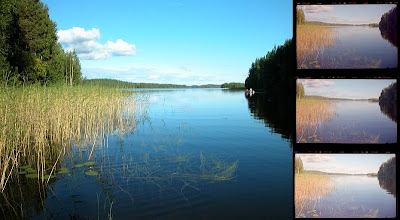 Recently I was working on 3 images taken for testing how Fuji Pro160S responds to over exposure. I took the shots on an bright sunny contrasty day, and was scanning them with a mind for putting them on my page on setting film exposure with a digital camera. That article also explores how film reacts to light a little as well (or densitometery using a scanner under a different name). Anyway, this image to the left was taken with my digital camera (not altering the exposure it chose) then plugging that straight into the film camera I then took 3 exposures;
Recently I was working on 3 images taken for testing how Fuji Pro160S responds to over exposure. I took the shots on an bright sunny contrasty day, and was scanning them with a mind for putting them on my page on setting film exposure with a digital camera. That article also explores how film reacts to light a little as well (or densitometery using a scanner under a different name). Anyway, this image to the left was taken with my digital camera (not altering the exposure it chose) then plugging that straight into the film camera I then took 3 exposures;- equal to the digital camera
- +1 fstop
- +2 fstop
My first scans just contained washed out sky in the +2 exposure. So there was the challenge of scanning this "difficult" negative and getting all of what I could see in that scan onto my file to start working with. This proved to be a bigger test of my scanner than I had thought, and has taught me much about both colour negatives (their dye layers), my scanner and has coalesced much of what I've leant and heard about scanning in the last 10 or so years (as an amateur scanner).
In a previous post I explored the linearity of my (this) Epson 3200 flatbed scanner. In a more recent post about trying to get more optimal exposures and or scans of Negative I began talking to a fellow and in thinking about things and rescanning things I stumbled across an interesting point:
scan times varied with different settings of my scanner.
I had not noticed this before, although I had noticed that covering the calibration area on the scanner does also alter scan times. Some time ago I spent some time fiddling about with this in an effort to appreciate if this makes a difference and published my discussions here on photo.net.
 As perhaps you can see (graph from my previously mentioned Blog page) covering the calibration area made little real difference to the response in the darkest areas of the negative. Sure the scanner perhaps increased exposure but as the density got higher (film got darker) the results were approaching the same. Probably the sensor was running out of sensitivity.
As perhaps you can see (graph from my previously mentioned Blog page) covering the calibration area made little real difference to the response in the darkest areas of the negative. Sure the scanner perhaps increased exposure but as the density got higher (film got darker) the results were approaching the same. Probably the sensor was running out of sensitivity.So, I went back to just doing things normally (not trying to fool the scanner.
It wasn't until I was testing the software NegPos. I was seeing decidedly more noise in the scans done with it than I was when I did plain "negative" scans using the Epson software to scan my negative as Negative. I thought that this warranted some exploration.
The first thing which is significant here is that NegPos software requires you do a full scale linear scan with your scanner (to make its internals maths easier), while when I scan with Epson scan I tune the the histogram in its software.
I have become sure that speckly noise in dense areas of scans of negatives is caused by scanner noise (things like the sky and clouds, which is also where "pepper grain" noise is located). However I noticed that when tuning the histogram myself I got less of this than with a full linear scan.
So, lets look at my process (and I suggest that you try to repeat theses results yourself).
The question often arises should I adjust my scan in the scanner softare or in photoshop? People argue that there should be no difference because this will result in software doing the same things just in different places.
This is only true if nothing changes about the way that the scanner obtains the data. For example proponents of vuescan will prefer to do a "linear scan" and save the raw data of that (which is essentially scanning as a positive and then inverting).
this next paragaph is complex, so you might need to read it twice:
As well, due to the I've found however that on my Epson 3200, with the driver in the Professional mode, that adjusting the sliders in the scan software further towards the dark area does make a physical change in scanning (I'm sure this will apply to 4870, 4990, V700/750 series scanners as they use the same software as far as I know).
For example a linear full range scan @ 1200 dpi of a segment of negative will take 1min 39 seconds while a histogram adjusted scan of the exact same thing at the same dpi takes just under 5 minutes.
That's nearly double the time. So I suspect that it is doing something like giving the CCD's longer exposure.
To repeat and summarize the above: I gained a change in scan time by just moving the dark slider to force the scanner to scan more of the dark area. This then may effectively be a hardware adjustment.
Lets look for some evidence to see if it may be. To cover any assumptions, below are the two different setting groups that I'm meaning with the discussion of settings. There is the all channel view and the split channel view:
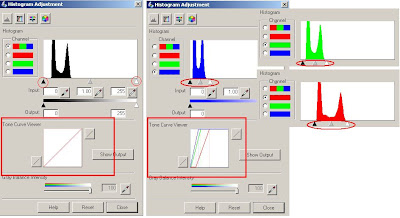
On the left side is a full range linear scan, on the right is also a linear scan, but I have adjusted the individual channels to optimize what is in the range. You scan see they are still linear by the tone curve viewer (although there is much greater contrasts applied because the each cover a different range).
 Note: Colour negative film is not like slide film in an important way (aside from being negative), each of the film layers reacts differently to light.
Note: Colour negative film is not like slide film in an important way (aside from being negative), each of the film layers reacts differently to light.If you look at the chart to the left (which is the response curves for Fuji Pro 160S negative film) you will see that the starting point at the left is denser for blue than it is for red or green light. This is a point which confuses many (and took me some time to grasp too).
Essentially it means that if you expose a grey card as grey then the density (say, at -1 on the axis) for each channel will be different.
Don't glaze over here (as its easy to) as there is no magic to density, it just means how dark your exposed bit is on the negative. Look again at the histograms above and you will see that red is over on the right (indicating that it is not as dark) and blue is over on the left (indicating that it is dark).
So, to set your scan levels appropriate to each channel is exactly what is needed for film (and why simply scanning and inverting will look ugly and need work to fix. Scanner software does this automatically, but I have found it is far to agressive chopping off high light and shadow details.
Note 2: if you change the scanner mode to Film Type: Color Negative Film you will not get a straight line in the tone curve viewer and if you inspect the channels you'll find its more like this. Note that the location of the histograms is on the opposite end of the scale now. Also note the clipping applied (differently) to each channel.
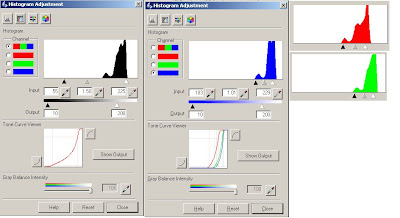
To the left I've simply left it to defaults, to right I've used the Epson "auto exposure" tool. This is why I prefer to scan as positive and invert in photoshop later ... to avoid the software doing what I don't want it to
You can see that it is clipping some of the darker and lighter ends of the negative (probably just to make sure) and adjusting the slope on the gamma (contrast) to be quite steep and is setting different black and white points for each channel.
I could (and sometimes do) manually trim or tune these right here, but I thought that to get the maximum control over this I would scan as positve (so Gamma can remain linear) optimize the channels, and then invert and apply curves as required in my photo editor. I thought that the easiest "quick" experiment was to scan a portion of the neg in three ways:
- full range linear scan
- partial range linear scan (that is to reduce how far into the 'light area' I bother scanning but leaving the dark areas untouched)
- lastly a fully "optimised" scan (where I look at setting black and white points for each R G and B colour channel separately).
To give you some idea of the differences I am seeing I've put below a screen grab of the three blue channel sections I obtained by scanning just this way.
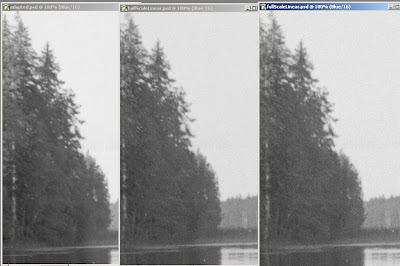
I think you can see that there is impressively less noise in the optimised scan than the others (and the worst is the full linear scan). That there is this difference supports the theory that a scan is not a scan and that its not just the software making the difference.
This is what I got (with some playing with levels and curves myself) from my adjusted VS the Epson auto negative.
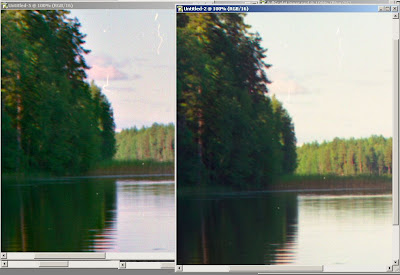
So with no effort Epsons stuff produces an OK result. But this negative had been "over esposed" by 2 stops to get better detail in the shadows (not to wash out the sky). So for me it was worth playing with this to keep that sky detail.
So if my theory is correct, and given that ColorNeg works with the full range scan its hardly surprising to find that there is some noise in the blue channel with this scanner. Compare the results of the two scans in the Blue channel:

So, for my scanner this settles the issue that setting the levels properly in the scan does make a difference. Even if I prefer the 'look' or the simplicity of the conversions that the CF software gives, I can't use it if I want to optimize my scans to keep away from the noise in the system.
So I'm comfortable with my workflow here with this scanner.
This is probably enough for most people (wait, I hear someone already crying out "No ... the short answer please!").
But ... for the gear heads among us I thought I'd try to see "why is it so". (the rest can skip reading now ;-)
Lets go back to our old friend the step wedge and see what happens when I alter the scan to make the input range from all R G and B from 0 to 50 (rather than 0 to 255).
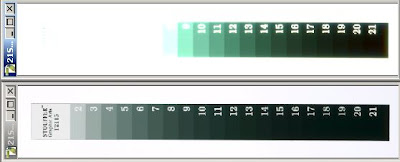
Well, for one thing, we loose lots of data up the top there (but then that's not surprising). We can see we also loose linear responce of the sensor as its now gaining a colour cast. But what we really need to know is: is the neg denser than the scanner can penetrate? I think it isn't because when I put them both on the glass and scan them in this way I get the following.
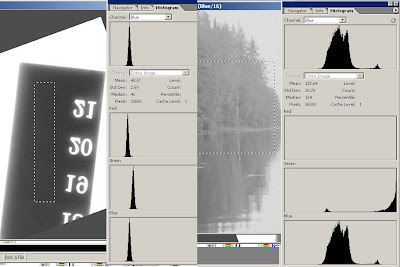
Note that the blue spike is very marginally on the darker edge of where the darkest parts of the blue in the negative lay? This does however mean that colour negative is right on the limits of this scanner (not so for black and white negative though).
Correcting for this shift is non trivial btw, as you'll notice that the spikes are not aligned, this is much less so on a linear scan done more within the limits of the scanner.
If we measure the values of each of the known stepwedge incriments we can check how well the scanner performs optimised in this range. I've plotted this in excel taking a rectangle in the center of each of the steps and plotted this both as a value with a Log value of this (as the steps are in 1/2 stops) to check for its accurate responce. Beside this I've also plotted another graph with the percentage error for each step. This is provided by the standard deviation of the measured rectangle around the median (Photoshop does this for me) as a percentage of the value.

So as we get further past 15, the percentage error starts rising to above 20%. Meaning we can't really rely on the accuracy of the scan here (meaning increased noise). This means that we can't easily rely the points for red green and blue being where we may predict them to be. As I see it we have to balance by eye rather than algorithm. So pale blue skies and bright clouds might be available but not without some work.
Therefore just how we approach getting at the blue channel in the colour negative and how we adjust it carefully will have a large impact on the image quality and on the amount of noise in the skys.
 So, now I understand more of why people say "scanning negatives is harder than scanning slides" as well as why colour negatives represent more challenge to scanners than black and white ones.
So, now I understand more of why people say "scanning negatives is harder than scanning slides" as well as why colour negatives represent more challenge to scanners than black and white ones.I would very much appreciate results of such explorations done on other scanners (such as Nikon or Imacon), but I expect that "drum" scanners will have far fewer troubles in this area.
:-)











3 comments:
Subsequently to this article I have obtained and am using a Nikon. I have placed my workflow here elsewhere on this blog. Essentially while there IS an analog gain adjustment on the Nikon it is not a "get out of jail card" and introduces its own issues. Essentially though its not needed if (as per the Epson) you scan Neg as Positive then customise the levels for each.
Hi! I came across this post after experiencing some frustrating noise and lines in the highlights of some negs I was trying to scan.
I have a good workflow for my 35mm slides with Vuescan and my Canon FS4000, so I didn't think I'd have any problem scanning some 120 negs on my Canoscan 8000F. Wrong! But, I can confirm that my Canon does indeed also not just rely on software trickery pertaining to the levels adjustments, at least when scanning as a positive.
I was thiiiis close to buying ColorNeg, but, although I did like the ease with which I could get nice color, I was still getting the noise in the highlights. I decided to look for another way before purchasing and am glad I did.
Thanks a lot for posting your findings.
Brent
"Chow" left this comment:
Wow, thanks for this great article. I've been wrestling with my scanner's settings and your series is one of the clearest expositions on how to work with its limitations (I have a Epson V500).
I notice you say to "adjust with the eye rather than by algorithm", and it's definitely going to take more practice developing that eye.
Post a Comment